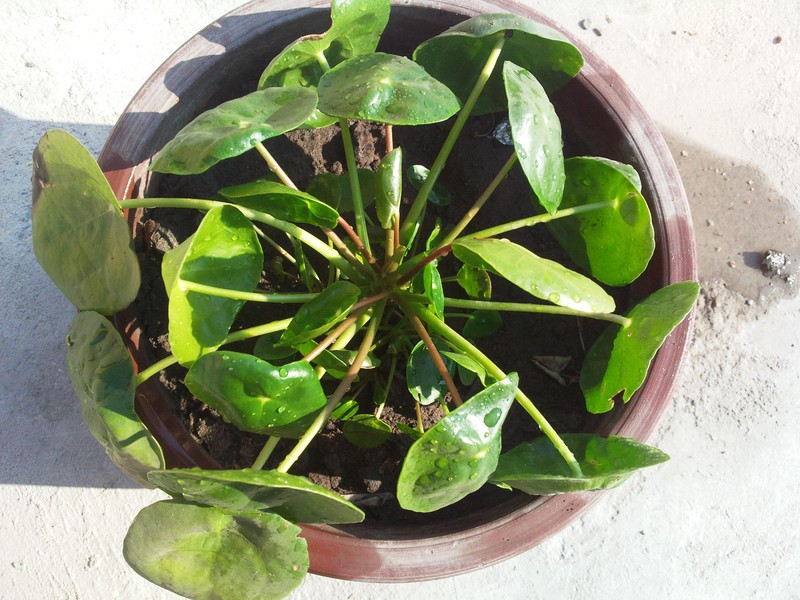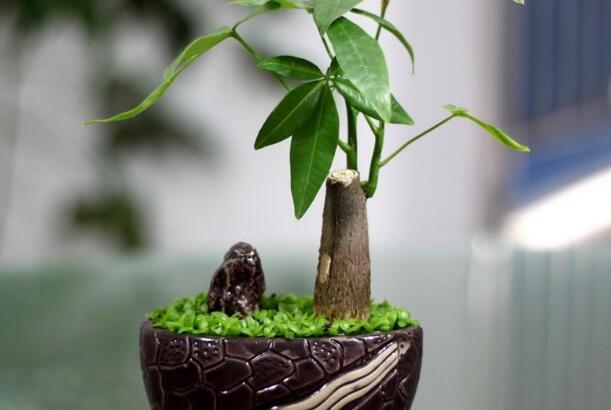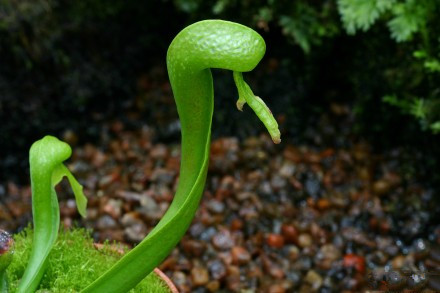Culture methods and matters needing attention of mirror grass
During the growing season, thin fertilizer is applied once every half month, but it should be noted that excessive nitrogen fertilizer will cause excessive leaf growth. It is easy to bloom and bear fruit in warm areas. Planting should be done with well-drained humus soil mixed with sand. And cushion the bottom of the basin to facilitate drainage.
breeding
Appropriate to choose loose, fertile, rich in humus sandy loam, available garden soil, decaying soil, river sand equal mixed preparation. Always keep the soil moist. Thin liquid fertilizer is applied once every half month in the growing season. Bloom and bear fruit easily in warm areas, and propagate by seeding. General use of ramets or cuttage method can be, every year from March to May is the best time for ramets and cuttage. Mirror grass is dioecious, flowering April, fruit period 5~6 months, in Yunnan can be seeded reproduction; mirror grass seeds are small, sowing depth should not be deep, sowing depth is not easy to emerge. Mirror grass is cold-resistant, can safely winter outdoors in the south, it likes shade, should be maintained in a place with shade conditions, growth temperature is about 15 degrees Celsius, in the greenhouse with sufficient light also grows well, generally used as potted ornamental. When planting, mix well drained humus soil with sand; and use tiles to cushion the bottom of the basin to facilitate drainage.

Mirror grass + shade resistance, as long as you can see-like newspaper light can grow, so it is very suitable for family indoor potted plants. It likes warm, humid environment, below-4 degrees Celsius that appears chilling phenomenon, leaf color tarnish or even fall off. Likes loose drainage good humus-rich loam, can be taken from the mountain shade humus soil; also available humus soil, peat plus a little river sand, coal ash, base fertilizer. Propagation-generally available ramets, leaves or branches inserted, etc. Mirror grass roots are easy to form adventitious buds, grow out-some small plants of different sizes, spring temperature warmer when the knife can be used from the original plant cut down another plant, easy to survive. Because mirror grass is also easy to sprout cluster tillers on its stems, it can be carefully removed from its stems with sharp knives in late summer and early autumn, planted in clusters in red soil, placed in shade, watered with sufficient water, and kept moist with plastic film. The survival rate is also very high.
Leaf insertion can refer to Begonia leaf insertion method. The stem can also be cut into about 3 cm segments for cuttage. If the leaves fall off due to freezing injury, but if the stems are not damaged, they can be maintained and managed according to the conventional winter, and the leaves can be re-released into adult plants in the spring of the green year. Do not put it in direct sunlight in summer. The whole spring and summer is the vigorous growth time of mirror grass, so fertilizer and water management should be strengthened, and 0.1%-0.5% potassium hydrogen phosphate solution should be often used for irrigation or foliar spraying, a small amount of nitrogen fertilizer should be supplemented irregularly in spring, and nitrogen fertilizer should be applied as little as possible or not in summer. During the whole growth period, the basin mainly keeps wet, and it can be relatively dry in winter, but it must not be dry, otherwise the leaves are easy to wither black. In dry season, water is often sprayed to the leaves and around, resulting in a humid environment. How to raise mirror grass, cultivation methods and precautions of mirror grass/Xi astigmatism irradiation
Mirror grass, named after the mirror whose leaves look like ancient immortals, is a beautiful foliage plant, which is loved by flower friends. In life, many people want to raise a pot of mirror grass at home. How do you raise mirror grass? The following is a small series of carefully organized potted mirror grass breeding methods and precautions, very comprehensive, do not miss oh ~
1. How to raise mirror grass and understand habits
Mirror grass likes warm, humid environment, it is cold-resistant like shade, avoid strong light, so mirror grass how to raise? When raised indoors, it should be placed in a place with sufficient astigmatism, and watered frequently to keep the basin soil slightly wet. As for cultivation soil, it is best to choose moist and well-drained peat soil.
2. Cultivation methods and precautions of mirror grass
1. Soil
How to raise indoor mirror grass, first of all, you should re-select the soil. Nowadays, the mirror grass of flower friends is basically bought online. There are existing potted plants. Normal maintenance can ensure the growth of plants, but the soil is very cheap. If you want the mirror grass to grow well, it is best to re-select the soil.
Soil selection: According to the growth habits of mirror grass, it likes loose fertile, well-ventilated soil. In this regard, Xiaobian recommends that you use 3 parts of rotten leaf soil, 3 parts of garden soil, 2 parts of river sand or furnace ash, 1 part of decomposed organic fertilizer mixed soil. It is best to pad tiles at the bottom of the pot to facilitate drainage.
2. Light
Mirror grass is a foliage plant, so the demand for light is very large, but it bogeys strong light, so when cultured indoors, it should be placed in a place where astigmatism is sufficient, but it can avoid strong light.
Note: Mirror grass has high requirements for light, not too strong, nor too hidden; once the light is too strong, its leaves are easily burned; once it is too shaded, the leaves are also easy to thin, and the petioles become longer and cause the leaves to droop.
3. Temperature
How to raise mirror grass, appropriate adjustment of temperature is also necessary. It is understood that mirror grass likes warm environment, the most suitable growth temperature is 15-20℃, to grow it well, it is best to keep this growth problem.
Note: Although mirror grass is cold-resistant, the winter temperature should be kept at 7℃, otherwise the leaves of mirror grass will be yellow, the leaves of mirror grass will curl, the leaves of mirror grass will fall off, and even frostbite will occur; at the same time, mirror grass is also afraid of high temperature. When the temperature is higher than 30℃, the plant will grow stagnant and the leaves will fall off easily.
4. Watering
Water is the source of life, and watering is an essential part of the cultivation methods and precautions of mirror grass. Because mirror grass likes moist environment, so in peacetime to water more, in order to keep the pot soil moist. Winter temperature is lower than 12℃ to control watering times, otherwise perishable, not conducive to winter.
Note: Mirror grass has high requirements for moisture. If watering is insufficient, it is easy to appear yellow and drooping leaves of mirror grass. In severe cases, wrinkles and even death will occur on the leaves. At the same time, mirror grass should avoid accumulated water. Watering should not be too much, otherwise it will cause discoloration of leaves, even root rot and death.
5. Fertilization
After watering, let's talk about fertilization, which is also very important in the cultivation method of mirror grass. Spring and summer is the growth period of mirror grass, at this time fertilization should be once every half month thin liquid fertilizer, at the same time should often use 0.1%-0.5% potassium dihydrogen phosphate solution irrigation or foliar spray.
Note: Because the mirror grass stems and leaves are fleshy, it needs fertilizer, but it is not tolerant of thick fertilizer and large fertilizer. When fertilizing it, it should be carried out many times in a small amount, and it is most appropriate to irrigate with thin fertilizer water. Once too much fertilization, will cause excessive leaf growth, plant lodging, serious will also cause plant root rot or even death.
6. Diseases and pests
During the growth of mirror grass, due to various reasons, the plant will inevitably cause pests and diseases. According to inquiries, the main pests and diseases are: scale insects, red spiders, leaf spot disease, anthracnose, etc., they will endanger the health of plants. Therefore, once found, we should immediately spray control, as for what medicine to spray, can refer to the mirror grass pest control.
How to grow mirror grass? Culture methods and precautions of mirror grass
Mirror grass is a perennial succulent herb belonging to Pilea genus of Nettle family, named after its mirror-like leaves. Mirror grass leaves unique, beautiful posture, very suitable for indoor planting, with high ornamental value, is a kind of foliage plant worthy of promotion. So, how do you grow mirror grass? The cultivation methods and precautions of mirror grass are described as follows.
Picture: Mirror Grass
1. Cultivation method of mirror grass
1. Soil: mirror grass potted soil can be used to decayed leaf soil, garden soil plus a little river sand, ashes, bone meal mixed culture soil. It is better to use loose, fertile, well-drained and humus-rich sandy loam. Family cultivation can be prepared by mixing 3 parts of moldy leaf soil +3 parts of garden soil +2 parts of river sand or furnace ash +1 part of decomposed organic fertilizer. When planting, it is necessary to mix well drained humus soil with sand, and use tiles to cushion the bottom of the basin to facilitate drainage.
2. Light: Mirror grass is shade-tolerant plants, but also like light, not strong light, scattered light is appropriate, too strong or too shaded, the leaves are easy to fade or disappear, too shaded, the leaves are easy to thin, petioles become longer and cause the leaves to droop. When the winter temperature is low, full sun maintenance can be given.
3. Temperature: The suitable growth temperature of mirror grass is between 15~20℃, and the winter should be kept above 7℃, otherwise it is easy to fall, or even freeze and die. In summer, when the temperature is higher than 30℃, the growth will stagnate and the leaves will fall off easily. In particular, it should be noted that a sudden drop in temperature will cause discoloration of the leaves and stems, and some will fall off. If the leaves fall off due to freezing injury, but if the stems are not damaged, they can be maintained and managed according to the conventional winter, and the leaves can be re-released into adult plants in the spring of the green year. Do not put it in direct sunlight in summer.
Picture: Mirror Grass
4. Humidity: mirror grass likes water and afraid of wet waterlogging, can keep the basin soil moist, drought easy wilting droop, serious leaves appear wrinkles or withered, death. It is not suitable for dry environment, the growth environment should maintain a high air humidity, and often spray water to the growth environment and leaves to humidify them, so that they grow well.
5. Watering: Mirror grass in winter temperature below 12℃ to control the number of watering, otherwise perishable, not conducive to winter. Always keep the pot soil moist, but avoid standing water to prevent leaf discoloration, wilting and even stem rot. Water should see dry see wet, in order to maintain air humidity, can often spray to foliage. During the whole growth period, the pot mainly keeps wet, and it can be relatively dry in winter, but it must not be dry, otherwise the leaves are easy to wither black. In dry season, water is often sprayed to the leaves and around, resulting in a humid environment.
6. Fertilization: mirror grass does not tolerate thick fertilizer and large fertilizer, should be carried out a small number of times, with thin fertilizer water irrigation is the most appropriate, the temperature is higher than 28℃ or lower than 12℃ should stop fertilization, the growth season every half a month thin liquid fertilizer once. The whole spring and summer is the vigorous growth time of mirror grass, so fertilizer and water management should be strengthened, and 0.1~0.5% potassium dihydrogen phosphate solution should be often used for irrigation or foliar spraying, a small amount of nitrogen fertilizer should be supplemented irregularly in spring, and nitrogen fertilizer should be applied as little as possible or not in summer. Thin liquid fertilizer is applied once every half month in the growing season, but it should be noted that too much nitrogen fertilizer will cause excessive leaf growth and plant lodging, and thick fertilizer and raw fertilizer will cause plant root rot or even death.
Picture: Mirror Grass
Second, the mirror grass farming precautions
Attention should be paid to the prevention and control of diseases and insect pests in the cultivation process of mirror grass. Anthracnose and scale insects are common in mirror grass. Anthracnose can be controlled by spraying anthrax, carbendazim, etc., and scale insects can be controlled by spraying pesticides and chlorpyrifos. Easily infected leaf spot disease, available 50% carbendazim diluted 600 times spray, once every ten days, continuous spray 3 times. There are blown cotton scale damage, available 40% omethoate diluted 1000 times spray leaves.
Mirror grass likes a warm and humid environment and is very suitable for potted plants in the family. The above introduces the cultivation methods and precautions of mirror grass for everyone, hoping to help everyone!
- Prev

How to make a rich tree lose its leaves? there are nine reasons why rich trees lose their leaves / water and fertilizer is the key.
Fortune tree, a very beautiful foliage plant, is well-built with emerald green leaves, which is not only beautiful, but also can purify the air. It is welcomed and loved by the broad masses of people. However, in the process of breeding, some flower friends will encounter the situation of losing their leaves, which is a great headache.
- Next

Key points of cultivation of cobra bottle grass
Cobra bottle grass is one of the genera of the family Cryptomellidae, which is a kind of insectivorous plant, mainly distributed in northern California and Oregon. Cobra bottle grass is a very well-known insectivorous plant species, named for its resemblance to cobras, and is the target of many players' collections. The left and right sides of their bottle caps stick together.
Related
- Fuxing push coffee new agricultural production and marketing class: lack of small-scale processing plants
- Jujube rice field leisure farm deep ploughing Yilan for five years to create a space for organic food and play
- Nongyu Farm-A trial of organic papaya for brave women with advanced technology
- Four points for attention in the prevention and control of diseases and insect pests of edible fungi
- How to add nutrient solution to Edible Fungi
- Is there any good way to control edible fungus mites?
- Open Inoculation Technology of Edible Fungi
- Is there any clever way to use fertilizer for edible fungus in winter?
- What agents are used to kill the pathogens of edible fungi in the mushroom shed?
- Rapid drying of Edible Fungi

